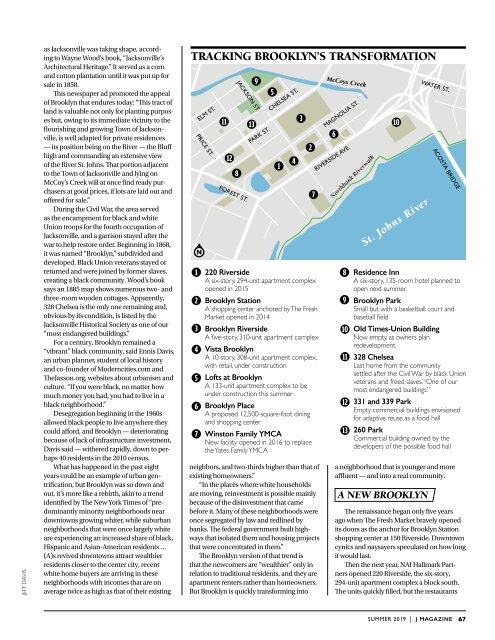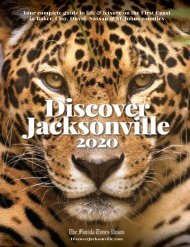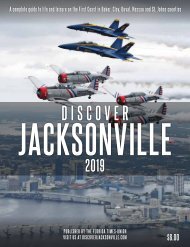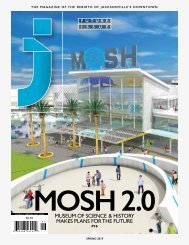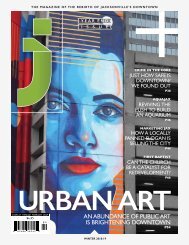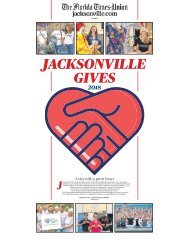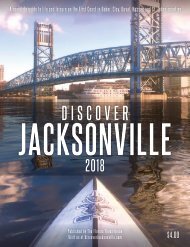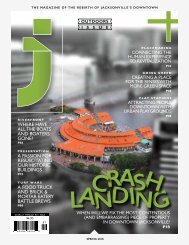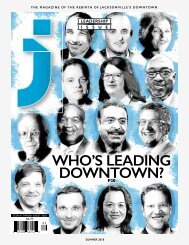Summer 2019
J Magazine, Summer 2019
J Magazine, Summer 2019
You also want an ePaper? Increase the reach of your titles
YUMPU automatically turns print PDFs into web optimized ePapers that Google loves.
JEFF DAVIS<br />
as Jacksonville was taking shape, according<br />
to Wayne Wood’s book, “Jacksonville’s<br />
Architectural Heritage.” It served as a corn<br />
and cotton plantation until it was put up for<br />
sale in 1858.<br />
This newspaper ad promoted the appeal<br />
of Brooklyn that endures today: “This tract of<br />
land is valuable not only for planting purposes<br />
but, owing to its immediate vicinity to the<br />
flourishing and growing Town of Jacksonville,<br />
is well adapted for private residences<br />
— its position being on the River — the Bluff<br />
high and commanding an extensive view<br />
of the River St. Johns. That portion adjacent<br />
to the Town of Jacksonville and lying on<br />
McCoy’s Creek will at once find ready purchasers<br />
at good prices, if lots are laid out and<br />
offered for sale.”<br />
During the Civil War, the area served<br />
as the encampment for black and white<br />
Union troops for the fourth occupation of<br />
Jacksonville, and a garrison stayed after the<br />
war to help restore order. Beginning in 1868,<br />
it was named “Brooklyn,” subdivided and<br />
developed. Black Union veterans stayed or<br />
returned and were joined by former slaves,<br />
creating a black community. Wood’s book<br />
says an 1885 map shows numerous two- and<br />
three-room wooden cottages. Apparently,<br />
328 Chelsea is the only one remaining and,<br />
obvious by its condition, is listed by the<br />
Jacksonville Historical Society as one of our<br />
“most endangered buildings.”<br />
For a century, Brooklyn remained a<br />
“vibrant” black community, said Ennis Davis,<br />
an urban planner, student of local history<br />
and co-founder of Moderncities.com and<br />
TheJaxson.org, websites about urbanism and<br />
culture. “If you were black, no matter how<br />
much money you had, you had to live in a<br />
black neighborhood.”<br />
Desegregation beginning in the 1960s<br />
allowed black people to live anywhere they<br />
could afford, and Brooklyn — deteriorating<br />
because of lack of infrastructure investment,<br />
Davis said — withered rapidly, down to perhaps<br />
40 residents in the 2010 census.<br />
What has happened in the past eight<br />
years could be an example of urban gentrification,<br />
but Brooklyn was so down and<br />
out, it’s more like a rebirth, akin to a trend<br />
identified by The New York Times of “predominantly<br />
minority neighborhoods near<br />
downtowns growing whiter, while suburban<br />
neighborhoods that were once largely white<br />
are experiencing an increased share of black,<br />
Hispanic and Asian-American residents …<br />
(A)s revived downtowns attract wealthier<br />
residents closer to the center city, recent<br />
white home buyers are arriving in these<br />
neighborhoods with incomes that are on<br />
average twice as high as that of their existing<br />
TRACKING BROOKLYN’S TRANSFORMATION<br />
ELM ST.<br />
PRICE ST.<br />
1<br />
2<br />
3<br />
4<br />
5<br />
6<br />
7<br />
N<br />
JACKSON ST.<br />
FOREST ST.<br />
PARK ST.<br />
CHELSEA ST.<br />
11 3<br />
13<br />
12<br />
8<br />
9<br />
220 Riverside<br />
A six-story, 294-unit apartment complex<br />
opened in 2015<br />
Brooklyn Station<br />
A shopping center anchored by The Fresh<br />
Market opened in 2014<br />
Brooklyn Riverside<br />
A five-story, 310-unit apartment complex<br />
Vista Brooklyn<br />
A 10-story, 308-unit apartment complex,<br />
with retail, under construction<br />
Lofts at Brooklyn<br />
A 133-unit apartment complex to be<br />
under construction this summer<br />
Brooklyn Place<br />
A proposed 12,500-square-foot dining<br />
and shopping center<br />
Winston Family YMCA<br />
New facility opened in 2016 to replace<br />
the Yates Family YMCA<br />
neighbors, and two-thirds higher than that of<br />
existing homeowners.”<br />
“In the places where white households<br />
are moving, reinvestment is possible mainly<br />
because of the disinvestment that came<br />
before it. Many of these neighborhoods were<br />
once segregated by law and redlined by<br />
banks. The federal government built highways<br />
that isolated them and housing projects<br />
that were concentrated in them.”<br />
The Brooklyn version of that trend is<br />
that the newcomers are “wealthier” only in<br />
relation to traditional residents, and they are<br />
apartment renters rather than homeowners.<br />
But Brooklyn is quickly transforming into<br />
5<br />
1<br />
4<br />
2<br />
7<br />
McCoys Creek<br />
MAGNOLIA ST.<br />
6<br />
RIVERSIDE AVE.<br />
Northbank Riverwalk<br />
8<br />
9<br />
10<br />
11<br />
12<br />
13<br />
10<br />
St. Johns River<br />
WATER ST.<br />
ACOSTA BRIDGE<br />
Residence Inn<br />
A six-story, 135-room hotel planned to<br />
open next summer<br />
Brooklyn Park<br />
Small but with a basketball court and<br />
baseball field<br />
Old Times-Union Building<br />
Now empty, as owners plan<br />
redevelopment<br />
328 Chelsea<br />
Last home from the community<br />
settled after the Civil War by black Union<br />
veterans and freed slaves. “One of our<br />
most endangered buildings.”<br />
331 and 339 Park<br />
Empty commercial buildings envisioned<br />
for adaptive reuse as a food hall<br />
260 Park<br />
Commercial building owned by the<br />
developers of the possible food hall<br />
a neighborhood that is younger and more<br />
affluent — and into a real community.<br />
a new Brooklyn<br />
The renaissance began only five years<br />
ago when The Fresh Market bravely opened<br />
its doors as the anchor for Brooklyn Station<br />
shopping center at 150 Riverside. Downtown<br />
cynics and naysayers speculated on how long<br />
it would last.<br />
Then the next year, NAI Hallmark Partners<br />
opened 220 Riverside, the six-story,<br />
294-unit apartment complex a block south.<br />
The units quickly filled, but the restaurants<br />
SUMMER <strong>2019</strong> | J MAGAZINE 67


